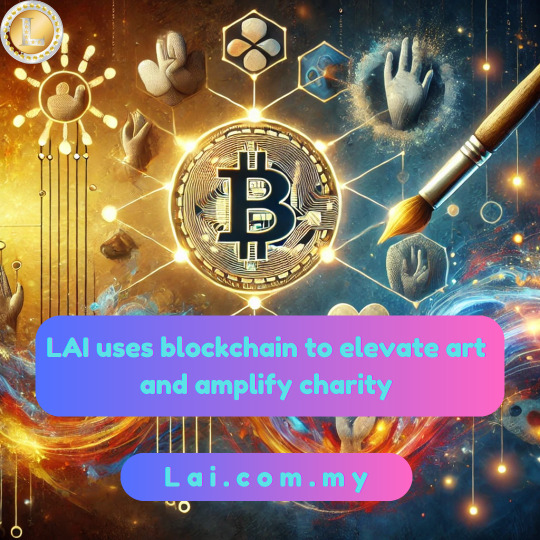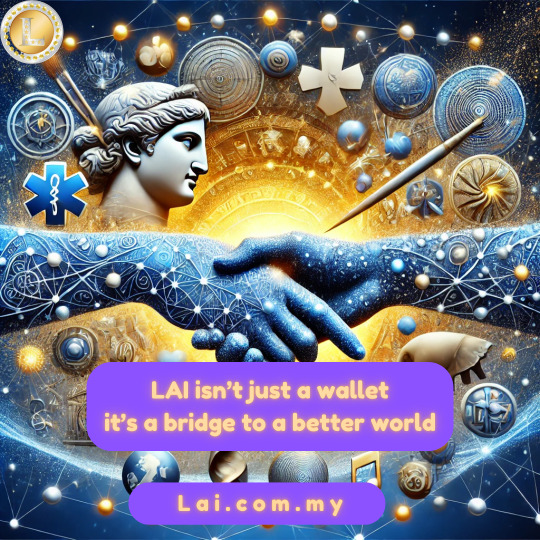#BlockChainForGood
Explore tagged Tumblr posts
Text
How Blockchain Secures Data Through Cryptography

In this episode of Unpacking Blockchain Technology, we explore one of the most critical components of blockchain: cryptography — the invisible shield that protects digital data, ensures transaction integrity, and powers trustless systems.
What Is Cryptography, and Why Does It Matter?
At its core, cryptography is the science of secure communication. It converts data into a coded format that only authorized parties can understand. In the world of blockchain, cryptography ensures that:
Transactions are secure and tamper-proof
Identities are protected
Data cannot be altered retroactively
Without cryptography, blockchain as we know it simply wouldn’t work.
Two Key Types of Cryptography in Blockchain
1. Hashing (e.g., SHA-256): Every piece of data in a blockchain is run through a hash function. This generates a fixed-length string of characters (the hash) that acts like a digital fingerprint. Even the slightest change to the data produces a completely different hash, ensuring data integrity.
2. Public-Key Cryptography (Asymmetric Encryption): This system uses two keys: a public key (shared with others) and a private key (kept secret).
You sign a transaction with your private key
Anyone can verify it using your public key
This mechanism ensures authenticity, non-repudiation, and secure value transfer between users.
Real-World Application: Bitcoin and Ethereum
In Bitcoin, each transaction is hashed and linked to the one before it — creating an unbreakable chain of trust.
In Ethereum, cryptography also secures smart contracts, automating interactions without revealing sensitive data.
Why Should You Care?
Whether you’re a developer, investor, policymaker, or just blockchain-curious, understanding cryptography helps you appreciate how:
Blockchain eliminates the need for third-party trust
Transactions stay secure, verifiable, and transparent
Your digital identity and assets are protected in Web3
Cryptography isn’t just a technical feature — it’s the foundation of digital trust in decentralized systems.
Tune in to Episode 7 now to demystify the cryptographic magic behind blockchain security.
Let’s Talk:
Do you think most people truly understand how their digital data is protected? Reply in the comments
#blockchaininnovation#blockchaintechnology#blockchainafrica#blockchainforgood#blockchainpodcast#cryptoeducation#decentralization#digitaltransformation#thabisonjoko#eswatini
0 notes
Text
Tokenization in Carbon Credits: A Blockchain-Powered Green Revolution
The Problem with Traditional Carbon Markets Let’s be real – today’s carbon credit system is kinda broken. Between questionable auditing, double-counting, and limited liquidity, it’s been tough for businesses to participate meaningfully in climate action.
But guess what? #Blockchain is changing the game.
How #Tokenization Fixes This According to Osler’s deep dive, tokenizing carbon credits means:
Transparent tracking – Every credit’s journey is recorded on-chain (no more shady offsets!)
Fractional ownership – Small businesses can buy just what they need
Instant settlement – No more 6-month waits to retire credits
Secondary markets – Credits become liquid assets
Cool Use Cases Already Happening A reforestation project in Brazil issuing NFTs for each planted tree A solar farm tokenizing future carbon offsets to fund construction An e-commerce platform letting customers offset purchases with micro-credits
What’s the most creative application of tokenized carbon credits you can imagine? Could we see carbon-backed #NFTs for sustainable fashion? Blockchain-verified ocean cleanup tokens?
Read Osler’s full analysis here
0 notes
Text




WHAT A PLEASURE TO SEE YOU AGAIN! Join me today at #PARIS #BLOCKCHAIN WEEK @ParisBlockWeek TO ACCELERATE #CHANGE at one of the world’s largest event for #Blockchain & #Web3 from APRIL 08 TO 10 in LE CARROUSEL DU LOUVRE in #Paris #PBW2025 #BlockChainForGood More at 👉 https://www.parisblockchainweek.com/
#ParisBlockchainWeek#PBW2025#RAISE2025#LeCarrouselDuLouvre#Paris#AIForGood#BlockChainForGood#GenAI#TechEvent#TopSpeakers#ArtificialIntelligence#AI#humanbe#blockchain
1 note
·
View note
Text
Blockchain in IT Recycling Enhancing Transparency and Security

Introduction
As the world increasingly depends on technology, electronic waste (e-waste) has become a growing concern. Businesses and individuals alike must ensure that their outdated devices are disposed of responsibly. However, a major challenge in IT asset disposition (ITAD) and e-waste recycling is transparency and security—ensuring that devices are properly recycled and that sensitive data is fully destroyed. This is where blockchain technology steps in as a game-changer.
At Techazar, we are always looking for innovative ways to make e-waste recycling, IT disposal, and electronic pick-up services more reliable and secure. In this blog, we explore how blockchain can revolutionize IT recycling by enhancing traceability, ensuring data security, and promoting compliance with e-waste regulations.
The Challenges in IT Recycling Today
1. Lack of Transparency
Many businesses and individuals dispose of electronic devices without knowing where they actually end up. Some of these devices are illegally dumped, leading to environmental hazards.
2. Data Security Risks
Even after formatting a device, sensitive business or personal data can still be retrieved. Improper disposal of IT assets poses a serious cybersecurity risk.
3. Compliance Issues
With regulations like Extended Producer Responsibility (EPR) and e-waste management laws tightening globally, companies need to ensure they follow proper IT disposal practices to avoid penalties.
How Blockchain is Transforming IT Recycling
Blockchain technology, best known for its role in cryptocurrencies, is now being applied to IT asset disposition and e-waste recycling to solve these challenges. Here's how:
1. Enhanced Traceability & Transparency
Blockchain creates an immutable ledger that records every step in the e-waste recycling process. This ensures that businesses and consumers can track their devices from collection to final disposal.
With blockchain-powered IT disposal systems, companies like Techazar can provide clients with real-time updates on their recycled assets.
Transparency builds trust by showing that e-waste is being handled in an environmentally responsible manner.
2. Secure Data Destruction Verification
One of the biggest concerns in IT recycling is data security. Blockchain enables:
Cryptographic verification of data destruction, ensuring that no sensitive information remains on disposed devices.
Smart contracts that automate secure asset tracking, ensuring compliance with IT disposal regulations.
Businesses can receive tamper-proof e-waste certificates, proving that their devices were responsibly and securely recycled.
3. Compliance & Regulatory Benefits
Regulatory bodies require companies to comply with IT recycling policies and EPR mandates. Blockchain makes compliance easier by:
Providing a secure, auditable record of e-waste disposal.
Helping organizations prove they’ve followed environmental laws.
Assisting companies in achieving certified IT asset disposition (ITAD) compliance.
Techazar’s Role in Blockchain-Based IT Recycling
At Techazar, we understand that businesses need secure, transparent, and compliant e-waste disposal solutions. That’s why we are exploring blockchain-powered recycling to offer:
Real-time tracking of e-waste disposal and ITAD services.
Digital certificates for data destruction, ensuring complete security.
Comprehensive reports to help businesses meet compliance regulations.
E-waste pick-up and recycling services that leverage the latest tech innovations.
The Future of Blockchain in E-Waste Recycling
Blockchain technology is still evolving, but its potential to revolutionize electronic recycling and IT disposal is clear. As more businesses embrace sustainable technology recycling, blockchain will play a key role in ensuring that every disposed device is accounted for, recycled responsibly, and securely wiped of data.
By integrating blockchain into e-waste recycling solutions, companies like Techazar are leading the way in making IT recycling more transparent, secure, and sustainable.
Conclusion
The future of IT recycling lies in innovation, and blockchain is set to redefine how we handle e-waste. With benefits like traceability, secure data destruction, and regulatory compliance, blockchain technology is bridging the gap between sustainability and security.
At Techazar, we are committed to providing best-in-class IT recycling services while embracing emerging technologies like blockchain to offer our clients unparalleled transparency and security.
If your business is looking for a trusted IT recycling company, reach out to Techazar today for secure e-waste disposal, IT asset management, and sustainable technology recycling.
Contact Techazar now to schedule your electronic pick-up.
#BlockchainTechnology#ITRecycling#EwasteManagement#SecureRecycling#Techazar#DataSecurity#SustainableTech#EwasteRecycling#CircularEconomy#DigitalLedger#ITAssetDisposition#GreenTech#ElectronicRecycling#TechSustainability#BlockchainForGood
0 notes
Text

LAI uses blockchain to elevate art, amplify charity, and foster meaningful global connections.
By merging technology with creativity and compassion, LAI empowers communities to drive positive change, support charitable causes, and inspire innovation through secure, seamless exchanges.
🎨🤝💙
0 notes
Text

We’re on a mission to reduce financial stress for workers globally. 🌐 Our EWA solution gives instant wage access. Explore how Volante helps communities overcome economic challenges.
Read more:volante-chain.com
0 notes
Text
Blockchain and Philanthropy: A Personal Journey Towards Trust, Transparency, and Traceability
In the ever-evolving landscape of philanthropy, the quest for trust, transparency, and traceability has led me down a path less traveled, where technology and social good intersect in the most innovative ways. My journey into the world of blockchain and its potential for revolutionizing philanthropy has been nothing short of enlightening. It's a narrative that intertwines my personal experiences with the broader implications of blockchain technology in fostering a more accountable and transparent world.
The Genesis of My Blockchain Epiphany
My exploration into blockchain was sparked by a growing disillusionment with traditional philanthropic practices. Stories of misallocated funds and opaque operations were becoming all too common, casting a shadow over the noble intentions of many impact-driven organizations. It was during this period of skepticism that I stumbled upon an intriguing concept: using blockchain technology to reimagine the foundations of philanthropy.
The idea was simple yet profound. Blockchain, with its decentralized ledger, immutable records, and transparent transactions, could offer a solution to the accountability and transparency woes plaguing the philanthropic sector. This revelation was not just a moment of clarity but a call to action. I delved deeper into understanding how blockchain could serve as the backbone for a new era of philanthropy.
Unpacking Blockchain's Potential for Philanthropy
At its core, blockchain is about trust. In a philanthropic context, this trust is twofold: trust that donations reach their intended destinations and trust that the impact of these contributions is real and measurable. Blockchain technology addresses these concerns through its inherent features.
Transparency: Blockchain's public ledger allows for a level of transparency previously unattainable. Every transaction, from donation to deployment, can be tracked and verified by anyone. This open access demystifies the journey of contributions, allowing donors to see exactly where their money is going and how it's being used.
Accountability: The immutable nature of blockchain records means that once a transaction is logged, it cannot be altered or deleted. This permanence ensures that organizations are held accountable for their actions, as every financial movement is permanently recorded and openly accessible.
Traceability: Blockchain enables the traceability of impacts. By tokenizing contributions and linking them to specific outcomes, it's possible to directly connect donations with the results they achieve. This not only provides donors with concrete evidence of their impact but also promotes a culture of result-based philanthropy.
My Personal Advocacy for Blockchain in Philanthropy
Inspired by the potential of blockchain to transform philanthropy, I became an advocate for its adoption. My mission was clear: to promote a philanthropic model that prioritizes transparency, accountability, and traceability. This wasn't just about championing a technology; it was about fostering a philanthropic ecosystem that values and rewards genuine impact.
In my advocacy, I've encountered both skeptics and believers. The skeptics question the scalability and practicality of integrating blockchain into existing philanthropic structures. The believers, on the other hand, see blockchain as the inevitable future of philanthropy—a tool that can bridge the trust gap and empower both donors and beneficiaries.
Bridging the Gap with Blockchain
The journey towards a blockchain-enabled philanthropy is not without its challenges. Technical complexities, regulatory hurdles, and the need for widespread adoption are significant barriers. Yet, the potential rewards far outweigh these obstacles. By harnessing blockchain, we can create a philanthropic landscape that is not only more efficient and transparent but also more inclusive and impactful.
For those interested in diving deeper into the intersection of blockchain and social change, I recommend exploring this insightful article. It offers a comprehensive look at how blockchain technology is paving the way for a new paradigm of trust, transparency, and accountability in social impact work.
Conclusion
My personal journey into the world of blockchain and philanthropy has been transformative. It has reshaped my understanding of what it means to give and how technology can enhance the integrity and effectiveness of philanthropic endeavors. As we stand at the cusp of this new era, the promise of blockchain offers a beacon of hope for a more transparent, accountable, and traceable philanthropic future. The path forward is clear; it's time to embrace the blockchain revolution in philanthropy.
1 note
·
View note
Text

🔹 William ten Zijthoff – Co-founder, Carbify 🌍🇳🇱
Bridging blockchain and climate action, William ten Zijthoff is revolutionizing carbon markets with Carbify’s certified carbon debit methodology. 🌱 As a UNFCCC Article 6.4 Expert, he shapes global climate policy and builds tech-driven frameworks for real-world restoration. 🎤 A visionary speaker and mentor, William empowers future leaders to innovate for the planet. 🔗 https://www.allaroundworlds.com/top-list/worlds-top-50-leaders/william-ten-zijthoff/ #WilliamtenZijthoff #Carbify #CarbonMarkets #ClimateInnovation #BlockchainForGood #SustainableFuture
#WilliamtenZijthoff#Aephoria#AgriTech#SustainableFarming#Top50Leaders2025#GreenLeadership#ClimateAction#AllAroundWorlds
0 notes
Text
Integrating Blockchain for Trustworthy Donations & Health Checkups at Large Events
Managing donations and free health checkups at large-scale religious events like Mahakumbh is challenging. Blockchain technology provides a secure and transparent solution to track donations and health services effectively. With Mahakumbh Coin, every contribution is recorded on the blockchain, ensuring funds reach the right place without middlemen. Donors can track their impact in real-time, while health checkups are managed efficiently. This blockchain-powered approach fosters trust, accountability, and seamless coordination, revolutionizing philanthropy at mass gatherings. 𝐑𝐞𝐯𝐨𝐥𝐮𝐭𝐢𝐨𝐧𝐢𝐳𝐞 𝐠𝐢𝐯𝐢𝐧𝐠 𝐰𝐢𝐭𝐡 𝐛𝐥𝐨𝐜𝐤𝐜𝐡𝐚𝐢𝐧—𝐬𝐞𝐜𝐮𝐫𝐞, 𝐭𝐫𝐚𝐧𝐬𝐩𝐚𝐫𝐞𝐧𝐭, 𝐚𝐧𝐝 𝐢𝐦𝐩𝐚𝐜𝐭𝐟𝐮𝐥 𝐝𝐨𝐧𝐚𝐭𝐢𝐨𝐧𝐬 𝐰𝐢𝐭𝐡 𝐌𝐚𝐡𝐚𝐤𝐮𝐦𝐛𝐡 𝐂𝐨𝐢𝐧! [email protected]
0 notes
Text

The role of crypto in philanthropy! 🤝💰 Discover how cryptocurrency is driving positive change through charitable donations, fundraising, and social impact initiatives. Fincop highlights stories of crypto-powered philanthropy.
#CryptoPhilanthropy #BlockchainForGood #PositiveChange #FincopStories #SocialImpact
0 notes
Text
Centralized vs. Decentralized Systems — What’s the Difference and Why It Matters

In today’s digital world, we often interact with systems that fall into one of two categories: centralized or decentralized. In Episode 5 of Unpacking Blockchain Technology with Thabiso Njoko, we take a deep dive into the meaning, structure, and impact of these two opposing system designs. Understanding the difference is fundamental to grasping why blockchain technology is so revolutionary.
What Is a Centralized System?
A centralized system operates under the control of a single authority or a tightly managed hierarchy. Most traditional institutions like banks, governments, social media platforms, and corporations run on centralized systems. This means all decisions, data storage, and access permissions flow through a central server or administrator.
While centralized systems are typically faster and easier to manage, they come with clear limitations. Chief among these are:
Single Point of Failure: If the central server crashes, gets hacked, or becomes corrupt, the entire system can go down.
Censorship Potential: Central authorities have the power to restrict access, remove content, or block users at will.
Trust Dependency: Users must place complete trust in the authority to handle data responsibly, ethically, and securely.
In many cases, that trust can be misplaced—leading to data breaches, surveillance, or misuse of power.
What Is a Decentralized System?
Decentralized systems, on the other hand, distribute control across a network of independent nodes or users. Blockchain is a prime example of this structure. In such a system, no single entity has complete authority. Instead, all participants collectively validate and record transactions or data entries.
Key benefits include:
Fault Tolerance: Even if one node fails or is attacked, the network remains operational.
Censorship Resistance: No central body can unilaterally block or remove users or content.
Trustless Architecture: Trust is embedded in cryptographic protocols and transparent consensus mechanisms, not in any one party.
Decentralized systems empower users and reduce reliance on gatekeepers, offering a more open, fair, and resilient infrastructure.
Why This Difference Matters
The distinction between centralized and decentralized systems is not just technical—it’s philosophical and political. It shapes how we interact online, store our wealth, manage our identities, and even express ourselves.
Blockchain technology, built on decentralization, provides an alternative to the current internet and financial models. It challenges monopolies, introduces transparency, and returns control to users. But it’s not without its challenges—scalability, user experience, and regulation are still evolving.
A Quick Comparison in Context
Let’s compare both structures using a practical lens:
Control: Centralized systems concentrate power; decentralized systems distribute it.
Failure Risk: Centralized = high risk from single-point failures; decentralized = lower risk, more robust.
Censorship: Centralized systems can restrict access; decentralized systems resist censorship.
Trust: Centralized systems require trust in authorities; decentralized systems rely on protocols and community consensus.
Final Thoughts
The shift from centralized to decentralized systems marks a fundamental transformation in how we design the future of the internet, finance, and society. Episode 5 invites listeners to examine where they place their trust and why blockchain’s decentralization may be key to a freer, more resilient digital age.
Whether you're just starting your blockchain journey or looking to strengthen your foundation, understanding this core concept is crucial. Be sure to revisit the episode for deeper examples and to reflect on how these systems shape your everyday digital life.
#blockchaininnovation#blockchaintechnology#blockchainafrica#blockchainforgood#blockchainpodcast#eswatini#cryptoeducation#decentralization#digitaltransformation#thabisonjoko
0 notes
Link
Follow on Twitter https://twitter.com/LochinvarLass LochinvarLass
1 note
·
View note
Text




TIME IS TICKING! DON'T FORGET TO GET YOUR TICKET FOR THE #PARIS #BLOCKCHAIN WEEK @ParisBlockWeek TO ACCELERATE #CHANGE at one of the world’s largest event for #Blockchain & #Web3 from APRIL 08 TO 10 in LE CARROUSEL DU LOUVRE in #Paris #PBW2025 #BlockChainForGood More at 👉 https://www.parisblockchainweek.com/
#ParisBlockchainWeek#PBW2025#RAISE2025#LeCarrouselDuLouvre#Paris#AIForGood#BlockChainForGood#GenAI#TechEvent#TopSpeakers#ArtificialIntelligence#AI#humanbe#blockchain
0 notes
Photo

Get our top services as per your demand in a pocket-friendly budget!
#etherummining#ethereuminvesting#ethereumblockchain#ethereumvenezuela#blockchainindonesia#blockchain3#blockchainforgood#blockchainweek#services#servicestation#developerindonesia#servicemakeup#developerstudentclub#software_engineering#softwareandroid
1 note
·
View note
Text

LAI isn’t just a wallet—it’s a bridge to a better world 🌍✨
Discover LAI, the revolutionary platform that goes beyond managing your digital assets. It's your gateway to a smarter, more connected future.
With LAI, secure transactions meet innovative features, empowering individuals and communities to create a better tomorrow.
Start bridging the gap today! 🚀
0 notes
Text

🌍 Discover how Volante's Earned Wage Access (EWA) solution is empowering workers worldwide with instant access to their wages. No more waiting for payday!
Learn more at volante-chain.com
0 notes